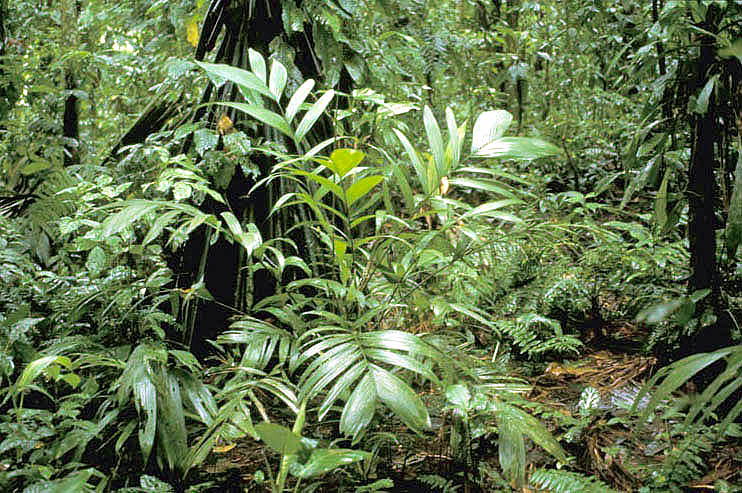Astrocaryum standleyanum
L.H.Bailey
Original
reference:
Gentes Herb. 3: 88 (1933)
Morphology:
Subcanopy palm. Stem solitary, to 15 m tall and 30 cm in diameter, armed with long black spines, often with one or more dead leaves hanging from the crown. Leaves forming a funnel or umbrella shaped crown, erect and arching, to 5 m long; pinnae ca. 100 on each side, arranged in groups of 2-5 and spreading in different planes, the central ones to 110 cm long and 3.5 cm wide. Inflorescences erect to arching, cream coloured, to 150 cm long; branches to 200, each with 3-5 female flowers on the basal part. Male flowers ca. 4 mm long. Female flowers 6-8 mm long including stigmas. Fruits obovoid, greyish green, turning orange at maturity, 5-6 cm long.
Distribution:
Central America to Ecuador W of the Andes, to 900 m elevation, but usually at lower altitudes, in non-inundated areas.
Common in somewhat seasonal, tropical moist forest in W Ecuador.
Common
names:
Guinol
–
Spanish
(Pedersen 1994a).
Mocora
–
Spanish
(Pedersen 1994a).
Poca-chi
–
Chachi
(Barfod & Balslev 1988).
Pucaishchi
–
Chachi
(Lindskoog & Lindskoog 1964).
Pucajchi
–
Chachi
(Lindskoog & Lindskoog 1964).
Pucashchi
–
Chachi
(Lindskoog & Lindskoog 1964).
Püka´´ – tci
–
Chachi
(Barrett 1925).
Uses:
Fibres from spear leaf pinnae are used commercially for manufacturing hats, mats, hammocks and furniture; harvest and processing of fibres is centered around Calceta in Manabí, furniture are made in Montecisti and Quito
(Pedersen 1994a).
The fruits and the palm heart are edible. Fruits are sold on markets in the town of Esmeraldas
(A. Barfod #60186
).
The palm begins to produce fruits after 5 years or more. It produces 1-4 infructesecences per year when immature, 3-5 per year when fully mature. Fruits are ripe between May and September. Each infructescence weighs 25-75 pounds or sometimes more, it has 200-300 fruits, yielding ca. 3 pounds of fat; 500 pounds of nuts can yield ca. 40 pounds of fat. The palm lives for 50 years or more. The oil is not commercialised in Ecaudor but it is in Colombia where the palm is even more abundant.
(Acosta-Solís 1971).
The trunk is used to make planks used for floor and different kinds of fences. The leaf is used to make ‘mocora’ hats, hammocks and baskets.
(Acosta-Solís 1971).
|
Latest posts by admin (see all)
- Aluminium Rattan Garden Furniture Design Ideas - September 11, 2019
- Popular Gardens and Parks in Sheffield, United Kingdom - September 18, 2018
- How New Eco-Friendly Garden Benches Help Plants and Consumers in the UK - February 26, 2018




Discussion: